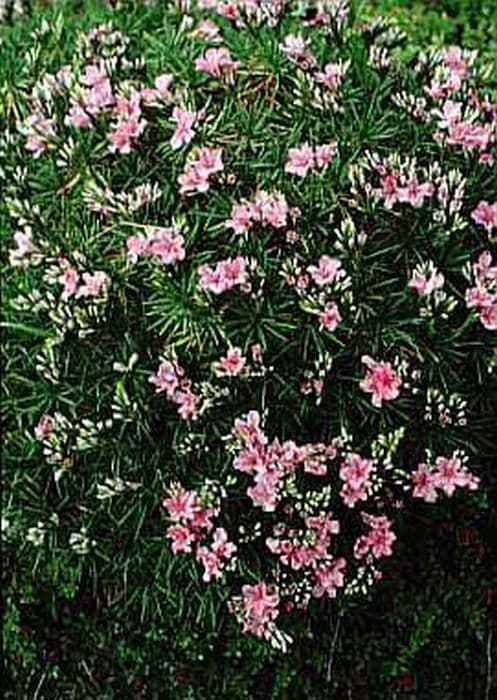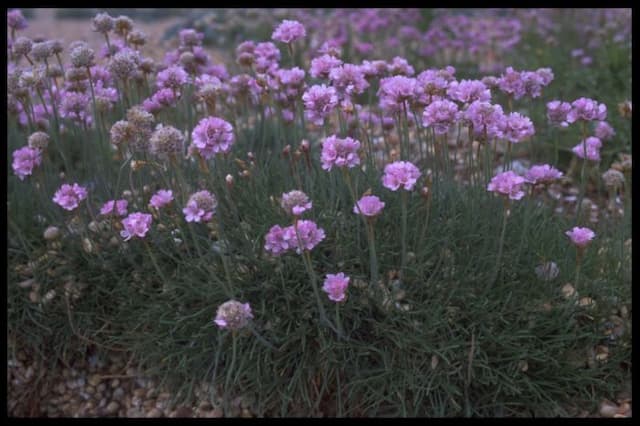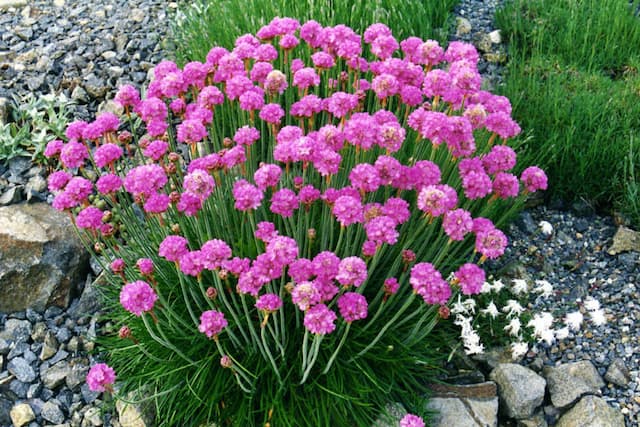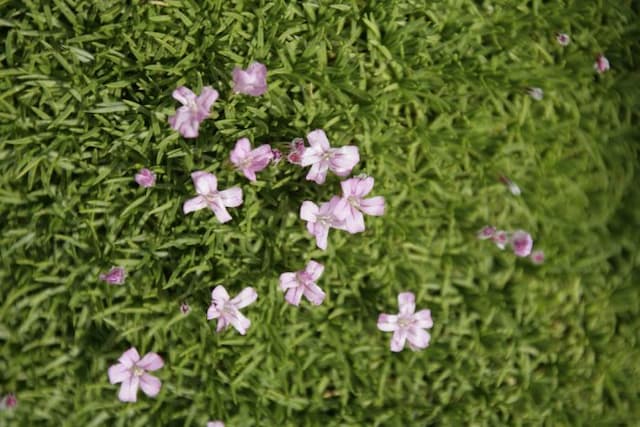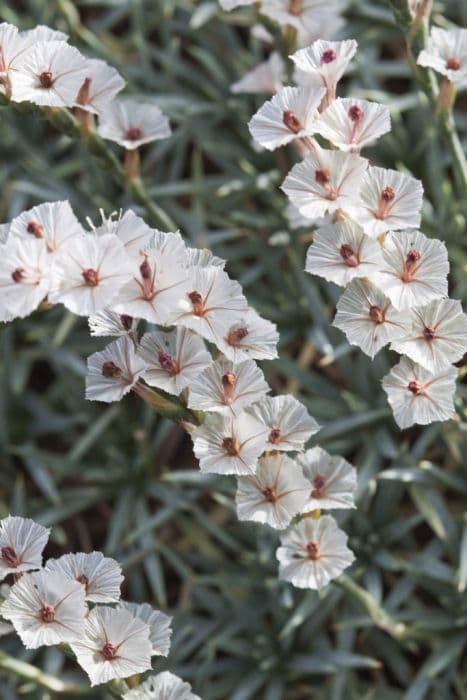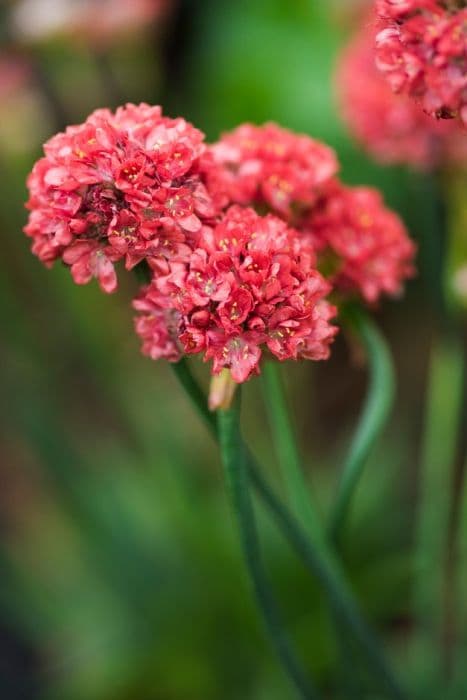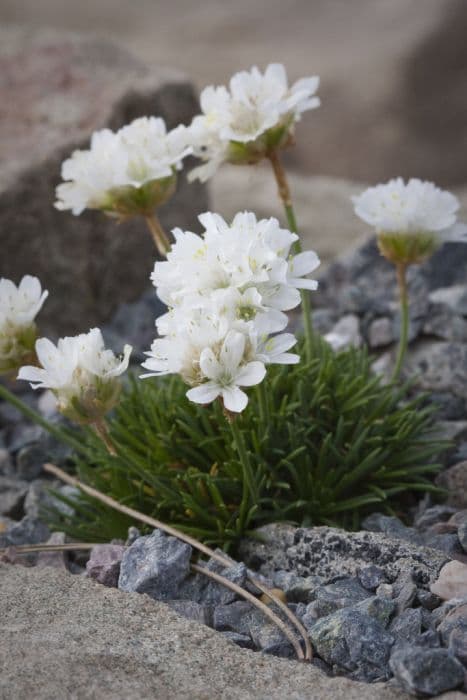False Sea Thrift Armeria pseudarmeria 'Ballerina Red' (Ballerina Series)

ABOUT
The plant known as 'Ballerina Red' is recognized for its vivid aesthetic. It has a showy display of deep, rich red flowers that are globe-shaped and clustered at the top of upright stems. The blooms provide a striking contrast with the tufted mounds of grass-like, evergreen foliage below them. The glossy, dark green leaves are narrow and create a lush, dense cushion that serves as the perfect backdrop for the intense floral color. The overall look of 'Ballerina Red' is neat and compact, with the flowers creating a delightful pompom-like effect that can add a touch of elegance to any garden setting. The brightness of the red blossoms makes it a favorite among gardeners looking to introduce bold colors to their floral arrangements or landscape.
About this plant
 Names
NamesFamily
Plumbaginaceae.
Synonyms
False Sea Thrift, Ballerina Red Sea Thrift, Ballerina Red Thrift.
Common names
Armeria pseudarmeria 'Ballerina Red'.
 Toxicity
ToxicityTo humans
False Sea Thrift (Armeria pseudarmeria 'Ballerina Red') is not commonly listed as a poisonous plant to humans. Ingesting any part of this plant is unlikely to cause more than mild gastrointestinal upset if consumed in large amounts. However, different people have different sensitivities, and some might experience more severe symptoms. Always exercise caution and avoid eating ornamental plants.
To pets
False Sea Thrift (Armeria pseudarmeria 'Ballerina Red') is not widely known to be toxic to pets. While it is not listed as a common toxic plant, it is generally recommended that pets do not ingest ornamental plants as they can sometimes cause gastrointestinal upset or other mild symptoms. If your pet consumes a large amount of the plant and shows signs of distress, consult a veterinarian.
 Characteristics
CharacteristicsLife cycle
Perennials
Foliage type
Evergreen
Color of leaves
Green
Flower color
Red
Height
1 foot [30 cm]
Spread
1 foot [30 cm]
Plant type
Herb
Hardiness zones
6
Native area
Europe
Benefits
 General Benefits
General Benefits- Easy to Grow: Thrives in a variety of conditions and is relatively low-maintenance.
- Attracts Pollinators: Draws in bees and butterflies, promoting pollination in the garden.
- Drought Tolerant: Once established, it can withstand periods of dry weather.
- Seasonal Interest: Offers vibrant red flowers that add color and interest to the garden from spring to summer.
- Compact Size: Its small stature makes it suitable for borders, rock gardens, or as a ground cover.
- Hardy Perennial: Resilient across many growing zones and will return year after year.
- Deer Resistant: Less likely to be eaten by deer, which can be beneficial for gardeners in rural areas.
- Evergreen Foliage: Provides year-round greenery, even when not in flower.
 Medical Properties
Medical PropertiesThis plant is not used for medical purposes.
 Air-purifying Qualities
Air-purifying QualitiesThis plant is not specifically known for air purifying qualities.
 Other Uses
Other Uses- Armeria pseudarmeria 'Ballerina Red' can be used in miniature gardens for a pop of color and as a scaled-down representation of natural landscapes.
- As a durable and compact plant, it serves well for creating intricate patterns in knot gardens and parterres.
- These plants can be potted and given as living gifts for special occasions such as weddings, anniversaries, or housewarmings.
- Dried Armeria flowers can be used for crafting, such as in the making of natural wreaths or as an addition to potpourri.
- Their vibrant blooms can be used as natural dye sources for fabrics or crafting projects with an environmentally friendly approach.
- Armeria can play a role in educational settings, such as school gardens, where children learn about perennial plant growth cycles.
- Photographers may use Armeria as a foreground plant in landscape photography to add depth and interest to their images.
- These plants can help stabilize coastal sand dunes due to their tolerance for sandy soil and salt spray.
- Thrift can be used in sensory gardens as it provides a soft texture for tactile exploration.
- As an attractant for pollinators like bees and butterflies, Thrift can be included in wildlife gardens to support local ecosystems.
Interesting Facts
 Feng Shui
Feng ShuiThe plant Armeria is not used in Feng Shui practice.
 Zodiac Sign Compitability
Zodiac Sign CompitabilityThe plant Armeria is not used in astrology practice.
 Plant Symbolism
Plant Symbolism- Strength: The genus name "Armeria" is derived from the Latin "armo," meaning "to arm or equip," reflecting the plant's hardy and resilient nature.
- Beauty: The 'Ballerina Red' cultivar, with its vibrant red blooms, is reminiscent of the grace and elegance of a ballerina, symbolizing beauty and artistic expression.
- Perseverance: Thriving in rocky and coastal environments, sea thrift represents the ability to endure challenging conditions and persist in the face of adversity.
 Water
WaterThe False Sea Thrift prefers consistent moisture but is quite drought tolerant once established. Water the plant thoroughly when the top inch of soil feels dry, which typically translates to once a week. During periods of high heat or extended drought, watering frequency may need to increase. It's best to water in the morning to allow for evaporation and to prevent fungal diseases. Aim for about one to two gallons per watering session, depending on the size of the plant and environmental conditions, to ensure the root zone is adequately moistened. Overwatering should be avoided to prevent root rot.
 Light
LightFalse Sea Thrift thrives in full sun conditions, so it should be placed in a location where it can receive at least six hours of direct sunlight per day. An ideal spot would be in a south-facing garden or against a wall that reflects sunlight. This plant can tolerate partial shade, but flowering may not be as prolific.
 Temperature
TemperatureFalse Sea Thrift plants are hardy and can tolerate a wide range of temperatures, making them suitable for many climates. They prefer temperatures between 60 to 75 degrees Fahrenheit but can withstand temperatures as low as 40 degrees and as high as 80 degrees Fahrenheit. To encourage thriving growth, it’s best to provide a stable environment within this ideal temperature range.
 Pruning
PruningPruning the False Sea Thrift is important to maintain its compact shape and encourage a new flush of blooms. Deadhead spent flowers regularly to promote continued blooming throughout the season. After the main bloom period in late spring or early summer, trim the foliage back by about one-third to refresh the plant’s appearance and stimulate new growth. Pruning is best done with clean, sharp shears to prevent any damage to the plant.
 Cleaning
CleaningAs needed
 Soil
SoilFalse Sea Thrift (common name) prefers well-draining soil with a mixture of sandy or loamy components. Incorporate organic matter like compost to enhance fertility. Ideal soil pH is between 5.5 and 7.5, leaning towards slightly acidic to neutral.
 Repotting
RepottingFalse Sea Thrift should be repotted every 2 to 3 years or when it outgrows its current container, to ensure continued health and blooming.
 Humidity & Misting
Humidity & MistingFalse Sea Thrift thrives in average humidity conditions and does not require any special humidity requirements. Average room humidity is generally sufficient for this plant.
 Suitable locations
Suitable locationsIndoor
Place in bright light, avoid overwatering, and provide good air circulation.
Outdoor
Plant in full sun, ensure good drainage, and space adequately.
Hardiness zone
4-8 USDA
 Life cycle
Life cycleArmeria pseudarmeria 'Ballerina Red', commonly known as False Sea Thrift, begins its life cycle as a seed, which upon germination, develops into a rosette of evergreen foliage. As temperatures warm in spring, it produces leafy stems that give rise to round clusters of deep pink to red flowers, attracting various pollinators to the garden. After the flowering period, if pollination occurs, seeds develop and are eventually dispersed to begin a new generation. Throughout the growing season, this perennial plant may produce multiple flushes of blooms if spent flowers are deadheaded. As autumn approaches, growth slows, and the plant enters a period of dormancy over the winter months, especially in cooler climates. In the following spring, the plant resumes growth from its root system, completing the life cycle and beginning anew.
 Propogation
PropogationPropogation time
Spring to Summer
Propogation: Sea Thrift 'Ballerina Red' is commonly propagated by division, which is a reliable and relatively easy method best done in spring just as new growth begins. To propagate by division, carefully dig up the plant and gently separate it into smaller clumps, ensuring that each section has a portion of the root system attached. These sections can then be immediately replanted in well-draining soil, spaced about 6-12 inches apart (15-30 cm) to allow room for growth. Water the newly planted divisions thoroughly and keep the soil moist until the plants are established and showing signs of new growth, which indicates successful propagation. This process allows gardeners to quickly expand their Sea Thrift 'Ballerina Red' collection or share plants with others.

